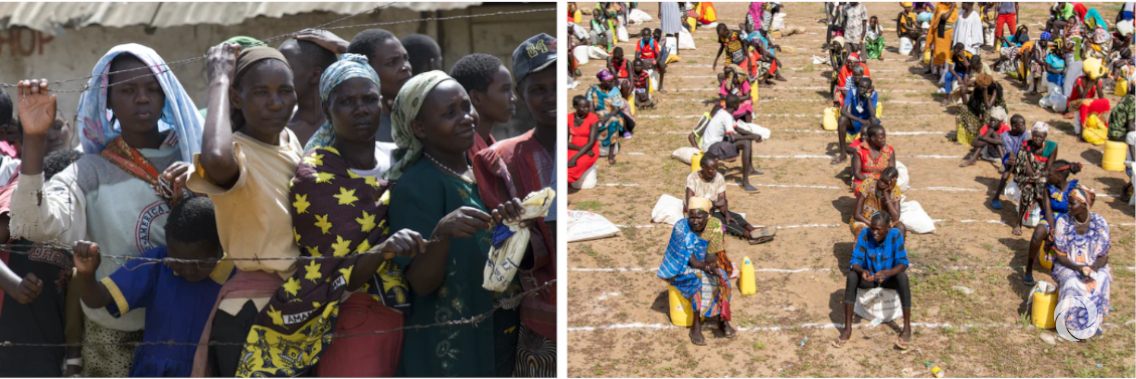Humanitarian needs were already at an all-time high before the Covid-19 pandemic and are now growing further. But just as humanitarian agencies try to gear up, they also must contend with the multiple new challenges that the virus brings with it.
Read below how humanitarian assistance looked like before the Covid-19 pandemic, and what it looks like now.
Physical distancing at relief distributions
Aid agencies are now practicing physical distancing at distribution sites, dividing people into small groups and asking them to stay 1.5 metres apart from one another. In several countries, including Afghanistan, Bangladesh, Djibouti, Ethiopia, South Sudan and Sudan, they are trying to minimize human exposure by distributing bigger food rations at less frequent intervals.
The World Food Programme (WFP), for instance, recently distributed two months of food to 130,000 Rohingya refugees in camps in Bangladesh, while the UN Refugee Agency (UNHCR) is doing the same in South Sudan and Kenya. Some aid groups in Syria and Ukraine are also doing door-to-door distributions to reduce crowding.
Handwashing stations and hygiene promotion kits
UN agencies like UN Refugee Agency UNHCR, WFP and UNICEF, as well as their NGO partners are installing handwashing stations wherever they can – in refugee camps, registration sites, transit centres, sites for internally displaced people, and in host communities. To encourage people to stay at home in South Sudan, humanitarian partners have created and distributed household kits with mosquito nets, home water treatment and soap to lessen the likelihood of malaria and other common illnesses from breaking out.
Temperature checks
In some relief sites and refugee camps, aid agencies like UNHCR are undertaking thermal screening to ensure that sick people are separated from others to reduce infection and give them the help they need.
Providing cash
Cash and vouchers can be delivered remotely and can give beneficiaries more autonomy, so humanitarian agencies and governments are looking at how to deliver more cash and voucher assistance instead of in-kind relief, wherever there is food to buy and the infrastructure for such assistance exists. For instance, cash assistance is being expanded in Djibouti, Myanmar and South Sudan. In some areas, WFP is also providing cash and vouchers to families at home whose children used to receive a daily meal through WFP’s school-feeding programmes.
Risk communications outreach
Humanitarian agencies are working with networks of community mobilizers to raise awareness among vulnerable populations about important health, safety and hygiene information. Reach out takes place through SMS, the media and social media, and in small community meetings. With a largely rural population, two-thirds of whom are illiterate and have poor digital connectivity, radio is the most powerful form of mass communication.
Education via radio and TV
With an estimated 90 percent of the world’s children out of school, humanitarian agencies such as UNICEF and Save the Children are turning to radio and, in some cases, television to educate children. For instance, in Rwanda, where 3 million students are now learning at home, UNICEF is working with NGO Inspire, Educated, Empower, the Rwanda Broadcasting company and the Ministry of Education to adapt reading, writing and math to radio formats, and transmit lessons daily.
Separating COVID-19 and non-COVID-19 treatment centres
There are huge concerns that COVID-19 will overwhelm already over-stretched health systems in humanitarian contexts. Aid agencies are trying wherever possible to set up COVID-19 triage sites outside of or separate to existing health clinics, so that people are not deterred from seeking help for ongoing health-care needs, such as child vaccinations, nutrition treatment and reproductive health care.
Procuring and producing PPE
Aid agencies are doing all they can to procure personal protective equipment (PPE), N95 masks, respirators, gowns and goggles for health staff – and for community mobilizers who need it – but global stocks are running woefully short, so aid agencies are taking creative measures. In Cameroon, OCHA has collaborated with the Israeli Embassy and the National Institute for Technology to produce masks and PPE using 3D printers. And in Haiti, humanitarian partners are working with the national textile industry to produce PPE.
Original source: UNOCHA
Published on 06 May 2020

